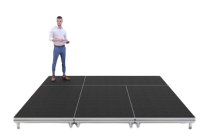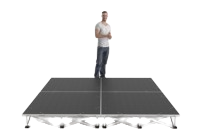Portable Stage
Portable stage equipment has become an essential fixture in halls, conference suites, houses of worship, and touring productions. Designed for fast build-up and break-down, it allows event organisers to create a stable performance surface almost anywhere. The following guide examines what makes portable staging reliable, how it is typically employed, and the main points to weigh up when selecting a product line.
Defining Portable Staging
A portable stage is a set of lightweight yet robust deck sections, leg assemblies, and connecting hardware that travels easily and goes together without heavy tools. Once locked in place it feels as solid as a fixed structure, but it can be dismantled and stored in minutes. Touring theatres favour this freedom; so do schools that share their assembly hall with sports users, and community venues that switch from weekly meetings to weekend concerts.
Modern designs rely on clever engineering. Frame pieces are precision-cut, so joints line up first time. Deck tops use plywood boards faced with hard-wearing hexa laminates. These materials resist scuffs, spills, and temperature swings far better than raw plywood from decades past. Legs slot into cast receivers or clamp beneath the deck, keeping everything square even on slightly uneven floors.
Benefits at a Glance
- Rapid Assembly – Push-fit fixings, fold-out legs, or captive thumbscrews keep build times short and remove the need for powered tools.
- Compact Storage – Sections nest together, reducing the footprint in store cupboards or backstage cages.
- Transport Ease – Individual elements are sized for a single person to handle safely; optional trolleys speed up load-outs.
- Scalable Size – Additional deck pieces may be hired or purchased later, allowing the performance area to grow with demand.
- Professional Appearance – Non-slip finishes, tidy edge profiles, and matching fascia panels present a tidy look on camera and in person.
Typical Users
Demand stretches beyond conventional theatres. Listed below are some of the sectors that rely on portable staging every week:
- Education – End-of-term plays, awards evenings, and choir performances often need a raised surface only for a short period.
- Corporate – Hotel ballrooms and meeting rooms convert into presentation suites for product briefings or panel discussions.
- Community & Faith Spaces – Multi-purpose halls benefit from flexible floor plans that can change between worship, sports, and concerts.
- Touring Arts – Fringe theatre companies and live bands take their entire set-up on the road, so packability is vital.
- Training Providers – Temporary instructional podiums are created for workshops, examinations, or speaking practice.
Engineering & Materials
High-grade steel or aluminium alloy frames underpin most portable stage decks. These metals combine strength with sensible weight. Joints are fully welded or secured with high-tolerance fasteners, ensuring no rattle once the stage is built. The deck surface usually carries a textured phenolic coating, delivering reliable grip for footwear while resisting dents and cleaning chemicals.
Beneath the deck, cross-bracing stops flex. Some models use telescopic or folding legs, whereas others keep the legs separate for maximum stacking efficiency. Rubber or nylon feet reduce vibration and protect polished floors. Selecting a height option is straightforward; fixed legs suit venues with one preferred level, while interchangeable legs cater for varied event formats.
Popular Stage Setups
The modular nature of portable stage equipment encourages creative layouts. Below are four favoured stage setups that repeatedly prove their worth:
- Single Block – A simple rectangular shape works for speeches, acoustic acts, or award ceremonies.
- Split Levels – Staggered heights give visibility to choirs or tiered seating arrangements.
- Catwalk Format – Long, narrow catwalk stage runs push the action closer to the audience during fashion shows or product reveals.
- Corner Layout – L-shaped builds fit awkward rooms or create a thrust stage, drawing audiences around the action.
Linking brackets keep deck joins tight, and additional braces may be fitted when higher builds demand extra rigidity.
Planning Factors Before Purchase
Selecting the right portable stage means balancing several practical concerns:
- Dimensional Needs – Work out the maximum number of performers and any equipment that shares the surface. Allow headroom for lighting booms if the stage height increases.
- Floor Loading – Check the venue’s structural rating. The manufacturer’s load capacity per square metre must sit comfortably within that limit.
- Frequency of Moves – Daily builds favour folding legs and trolley packs; annual events may live with more component parts if budget is tight.
- Access – Narrow doorways or staircases govern the maximum panel size that can reach the event space.
- Accessory Range – Stage deck accessories such as valances, side infills, or storage carts can lift efficiency and finish.
Maintenance Practices
Portable staging asks little in return for years of service. Keep components dry, wipe dirt from deck tops, and avoid dragging frames across abrasive floors. Hardware such as wing bolts or quick-release latches benefits from an occasional dab of light machine oil. When stacking decks, interleave protective cloths to prevent surface scratches.
Summary
Portable stage solutions sit at the heart of flexible event planning. By understanding the mechanics behind their strength, the range of possible configurations, and the legislative framework that protects performers, decision makers can specify with confidence. Once in service, a well-chosen setup will adapt to countless productions, presentations, and celebrations for many years.





